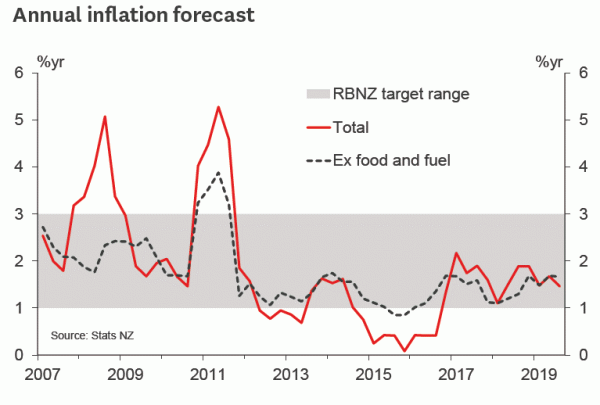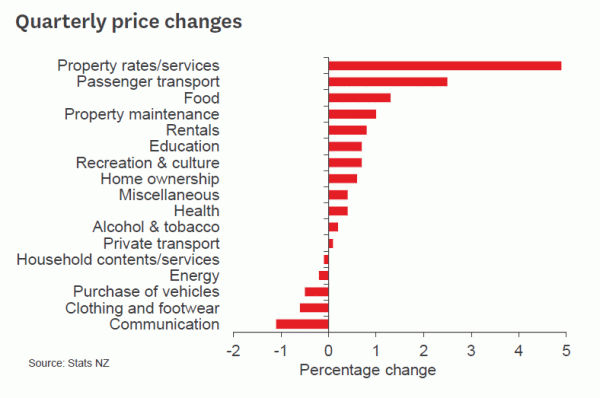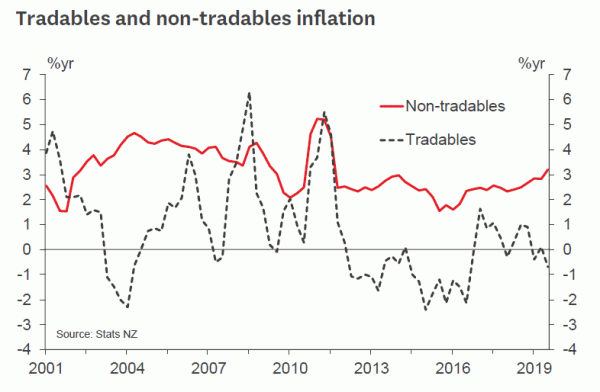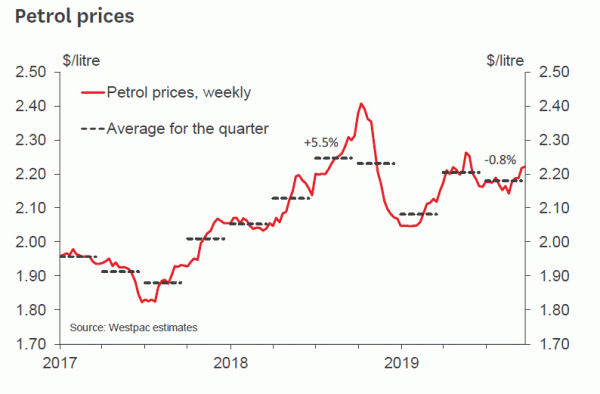- Consumer prices rose by 0.7% in the September quarter, higher than forecast.
- Annual inflation dipped to 1.5%, largely due to the variation in fuel prices.
- Non-tradables inflation rose to an eight-year high, demonstrating that easy monetary policy settings in New Zealand are having the desired effect.
- We continue to expect a further cut in the OCR to 0.75% in November, with rates remaining low for an extended period after that.
Inflation was a little higher than expected in the September quarter, with a 0.7% rise in the Consumers Price Index. The annual inflation rate dropped from 1.7% to 1.5%, largely due to the variability in fuel prices; underlying inflation looks to have been steady.
This result will be significant for the Reserve Bank. Not only was it higher than the RBNZ’s forecast of a 0.5% rise for the quarter, but all of the surprise was on the more persistent non-tradables side. Non-tradables prices tend to be driven more by domestic conditions, and hence are more receptive to monetary policy settings. The acceleration in non-tradables inflation over the last year, along with the recent signs of a pickup in the housing market, show that monetary policy is working in the areas where we would expect it to work.
The RBNZ is not off the hook by any means. Total inflation continues to linger in the lower half of the 1-3% target range, due to very weak price pressures on the tradables side. We expect the RBNZ to cut the OCR by another 25 basis points to 0.75% in November, a move that financial markets have already fully priced in. But we’re not forecasting further rate cuts beyond that, and the pickup in domestic inflation certainly gives the RBNZ some defence against having to resort to the dark arts of unconventional monetary easing.
Details.
The CPI rose by 0.7% in the September quarter, against our forecast (and the median market view) of a 0.6% rise. Seasonal items accounted for a fair amount of the rise in the index, though some of them rose by more than we expected. Non-tradables prices rose by 1.1%, against the RBNZ’s forecast of 0.7%. The annual rate of increase has picked up from 2.5% a year ago, to 3.2% today – the last time that it was this high was in 2011, and even that was temporarily boosted by an increase in the GST rate.
In contrast, tradables prices remain soft, with a 0.1% rise over the quarter leaving them down 0.7% on a year ago. Low global inflation and competitive pressures continue to hold down prices for many imported goods.
Petrol prices were 0.8% lower on average over the quarter. That compares to a 5.5% rise in the September quarter last year, which was due to higher world oil prices and the introduction of the Auckland regional fuel tax. The difference between these two quarters was enough to knock 0.3% off the annual inflation rate.
Food prices rose by 1.3% for the quarter, to be up 1.8% on a year ago. Meat prices were boosted by the African Swine Fever outbreak in China, which has squeezed global supplies of pork and created extra demand for other proteins. There was also a notable rise in prices for dining out, which may have been a delayed response to the large minimum wage hike in April.
Local body rates, which are reset once a year, rose by 4.9%. This was the second year in a row of large increases (and the second time that they have beaten our estimates). Given that rate increases in Auckland have been capped at 2% a year, this points to some substantial increases in the smaller regions, many of which have been caught out by the extent of population growth in recent years and are spending to catch up.
Housing-related costs made up a sizeable portion of the rise in prices. In addition to local body rates, there was a 1% rise in property maintenance costs and a 0.8% increase in rents. A recent change to the measurement of rents in the CPI means that they will tend to rise faster than they did in the past, though this won’t make a big difference to overall inflation, adding perhaps just 0.1% per year.
Price inflation for newly-built homes has continued to cool, in line with the slowdown in the wider housing market. But with record-low mortgage rates starting to stimulate the housing market again, we suspect that new home prices could also pick up again over the next year.
Domestic airfares jumped by 15.7% in the September quarter. Price increases are normal around this time of year, but this was an unusually large rise. We suspect that this has been a drawn-out response to the rebound in world oil prices over the last few years. When fuel costs rise, the typical first response is to reduce services or remove routes that are no longer profitable; that tends to be followed later by a rise in airfares on the remaining services. We think that this has further to play out in New Zealand.
Despite the upside surprises in today’s release, we don’t have any immediate reason to change our forecasts for the near term. We expect annual inflation to remain close to, but below, the 2% midpoint of the RBNZ’s target range over the next couple of years. The recent fall in the New Zealand dollar will temporarily boost tradables inflation, with the effects most likely to be seen over the first half of next year

















